Ryoki Hamano
CatCMA with Margin: Stochastic Optimization for Continuous, Integer, and Categorical Variables
Apr 10, 2025Abstract:This study focuses on mixed-variable black-box optimization (MV-BBO), addressing continuous, integer, and categorical variables. Many real-world MV-BBO problems involve dependencies among these different types of variables, requiring efficient methods to optimize them simultaneously. Recently, stochastic optimization methods leveraging the mechanism of the covariance matrix adaptation evolution strategy have shown promising results in mixed-integer or mixed-category optimization. However, such methods cannot handle the three types of variables simultaneously. In this study, we propose CatCMA with Margin (CatCMAwM), a stochastic optimization method for MV-BBO that jointly optimizes continuous, integer, and categorical variables. CatCMAwM is developed by incorporating a novel integer handling into CatCMA, a mixed-category black-box optimization method employing a joint distribution of multivariate Gaussian and categorical distributions. The proposed integer handling is carefully designed by reviewing existing integer handlings and following the design principles of CatCMA. Even when applied to mixed-integer problems, it stabilizes the marginal probability and improves the convergence performance of continuous variables. Numerical experiments show that CatCMAwM effectively handles the three types of variables, outperforming state-of-the-art Bayesian optimization methods and baselines that simply incorporate existing integer handlings into CatCMA.
CMA-ES for Discrete and Mixed-Variable Optimization on Sets of Points
Aug 23, 2024Abstract:Discrete and mixed-variable optimization problems have appeared in several real-world applications. Most of the research on mixed-variable optimization considers a mixture of integer and continuous variables, and several integer handlings have been developed to inherit the optimization performance of the continuous optimization methods to mixed-integer optimization. In some applications, acceptable solutions are given by selecting possible points in the disjoint subspaces. This paper focuses on the optimization on sets of points and proposes an optimization method by extending the covariance matrix adaptation evolution strategy (CMA-ES), termed the CMA-ES on sets of points (CMA-ES-SoP). The CMA-ES-SoP incorporates margin correction that maintains the generation probability of neighboring points to prevent premature convergence to a specific non-optimal point, which is an effective integer-handling technique for CMA-ES. In addition, because margin correction with a fixed margin value tends to increase the marginal probabilities for a portion of neighboring points more than necessary, the CMA-ES-SoP updates the target margin value adaptively to make the average of the marginal probabilities close to a predefined target probability. Numerical simulations demonstrated that the CMA-ES-SoP successfully optimized the optimization problems on sets of points, whereas the naive CMA-ES failed to optimize them due to premature convergence.
Tail Bounds on the Runtime of Categorical Compact Genetic Algorithm
Jul 10, 2024



Abstract:The majority of theoretical analyses of evolutionary algorithms in the discrete domain focus on binary optimization algorithms, even though black-box optimization on the categorical domain has a lot of practical applications. In this paper, we consider a probabilistic model-based algorithm using the family of categorical distributions as its underlying distribution and set the sample size as two. We term this specific algorithm the categorical compact genetic algorithm (ccGA). The ccGA can be considered as an extension of the compact genetic algorithm (cGA), which is an efficient binary optimization algorithm. We theoretically analyze the dependency of the number of possible categories $K$, the number of dimensions $D$, and the learning rate $\eta$ on the runtime. We investigate the tail bound of the runtime on two typical linear functions on the categorical domain: categorical OneMax (COM) and KVal. We derive that the runtimes on COM and KVal are $O(\sqrt{D} \ln (DK) / \eta)$ and $\Theta(D \ln K/ \eta)$ with high probability, respectively. Our analysis is a generalization for that of the cGA on the binary domain.
Natural Gradient Interpretation of Rank-One Update in CMA-ES
Jun 24, 2024
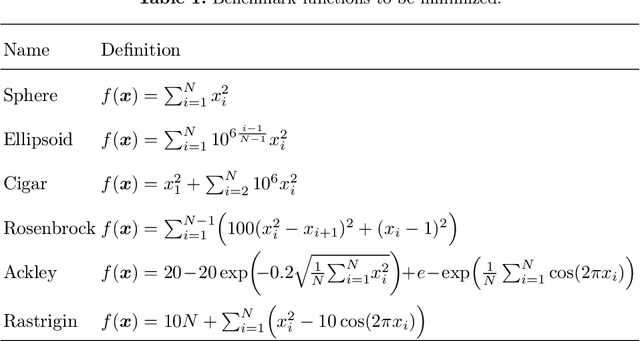
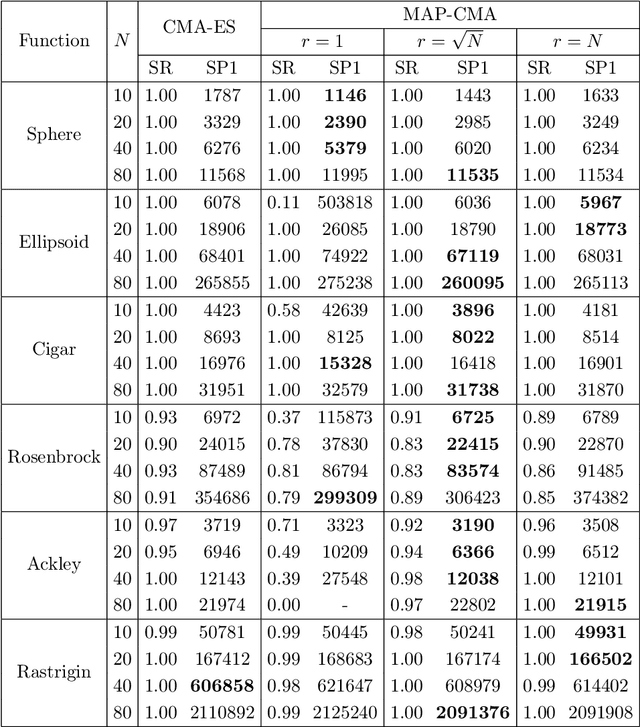
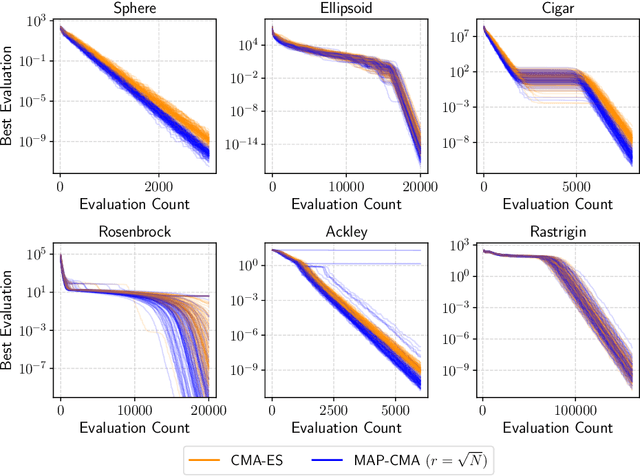
Abstract:The covariance matrix adaptation evolution strategy (CMA-ES) is a stochastic search algorithm using a multivariate normal distribution for continuous black-box optimization. In addition to strong empirical results, part of the CMA-ES can be described by a stochastic natural gradient method and can be derived from information geometric optimization (IGO) framework. However, there are some components of the CMA-ES, such as the rank-one update, for which the theoretical understanding is limited. While the rank-one update makes the covariance matrix to increase the likelihood of generating a solution in the direction of the evolution path, this idea has been difficult to formulate and interpret as a natural gradient method unlike the rank-$\mu$ update. In this work, we provide a new interpretation of the rank-one update in the CMA-ES from the perspective of the natural gradient with prior distribution. First, we propose maximum a posteriori IGO (MAP-IGO), which is the IGO framework extended to incorporate a prior distribution. Then, we derive the rank-one update from the MAP-IGO by setting the prior distribution based on the idea that the promising mean vector should exist in the direction of the evolution path. Moreover, the newly derived rank-one update is extensible, where an additional term appears in the update for the mean vector. We empirically investigate the properties of the additional term using various benchmark functions.
CMA-ES for Safe Optimization
May 17, 2024
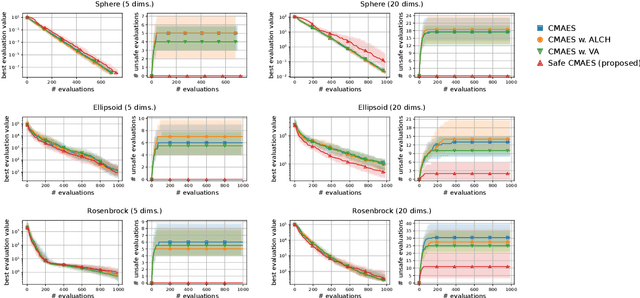
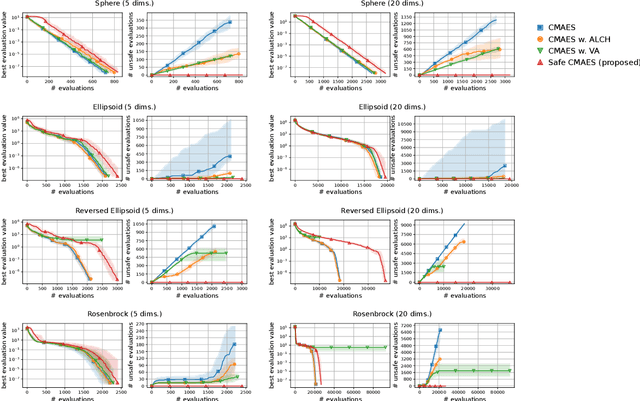
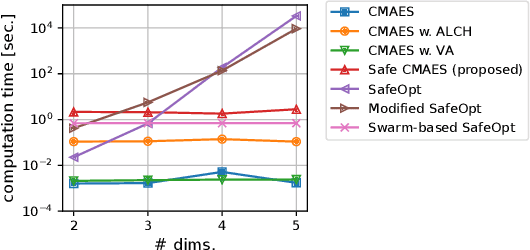
Abstract:In several real-world applications in medical and control engineering, there are unsafe solutions whose evaluations involve inherent risk. This optimization setting is known as safe optimization and formulated as a specialized type of constrained optimization problem with constraints for safety functions. Safe optimization requires performing efficient optimization without evaluating unsafe solutions. A few studies have proposed the optimization methods for safe optimization based on Bayesian optimization and the evolutionary algorithm. However, Bayesian optimization-based methods often struggle to achieve superior solutions, and the evolutionary algorithm-based method fails to effectively reduce unsafe evaluations. This study focuses on CMA-ES as an efficient evolutionary algorithm and proposes an optimization method termed safe CMA-ES. The safe CMA-ES is designed to achieve both safety and efficiency in safe optimization. The safe CMA-ES estimates the Lipschitz constants of safety functions transformed with the distribution parameters using the maximum norm of the gradient in Gaussian process regression. Subsequently, the safe CMA-ES projects the samples to the nearest point in the safe region constructed with the estimated Lipschitz constants. The numerical simulation using the benchmark functions shows that the safe CMA-ES successfully performs optimization, suppressing the unsafe evaluations, while the existing methods struggle to significantly reduce the unsafe evaluations.
CatCMA : Stochastic Optimization for Mixed-Category Problems
May 16, 2024Abstract:Black-box optimization problems often require simultaneously optimizing different types of variables, such as continuous, integer, and categorical variables. Unlike integer variables, categorical variables do not necessarily have a meaningful order, and the discretization approach of continuous variables does not work well. Although several Bayesian optimization methods can deal with mixed-category black-box optimization (MC-BBO), they suffer from a lack of scalability to high-dimensional problems and internal computational cost. This paper proposes CatCMA, a stochastic optimization method for MC-BBO problems, which employs the joint probability distribution of multivariate Gaussian and categorical distributions as the search distribution. CatCMA updates the parameters of the joint probability distribution in the natural gradient direction. CatCMA also incorporates the acceleration techniques used in the covariance matrix adaptation evolution strategy (CMA-ES) and the stochastic natural gradient method, such as step-size adaptation and learning rate adaptation. In addition, we restrict the ranges of the categorical distribution parameters by margin to prevent premature convergence and analytically derive a promising margin setting. Numerical experiments show that the performance of CatCMA is superior and more robust to problem dimensions compared to state-of-the-art Bayesian optimization algorithms.
-CMA-ES with Margin for Discrete and Mixed-Integer Problems
May 01, 2023



Abstract:The covariance matrix adaptation evolution strategy (CMA-ES) is an efficient continuous black-box optimization method. The CMA-ES possesses many attractive features, including invariance properties and a well-tuned default hyperparameter setting. Moreover, several components to specialize the CMA-ES have been proposed, such as noise handling and constraint handling. To utilize these advantages in mixed-integer optimization problems, the CMA-ES with margin has been proposed. The CMA-ES with margin prevents the premature convergence of discrete variables by the margin correction, in which the distribution parameters are modified to leave the generation probability for changing the discrete variable. The margin correction has been applied to ($\mu/\mu_\mathrm{w}$,$\lambda$)-CMA-ES, while this paper introduces the margin correction into (1+1)-CMA-ES, an elitist version of CMA-ES. The (1+1)-CMA-ES is often advantageous for unimodal functions and can be computationally less expensive. To tackle the performance deterioration on mixed-integer optimization, we use the discretized elitist solution as the mean of the sampling distribution and modify the margin correction not to move the elitist solution. The numerical simulation using benchmark functions on mixed-integer, integer, and binary domains shows that (1+1)-CMA-ES with margin outperforms the CMA-ES with margin and is better than or comparable with several specialized methods to a particular search domain.
CMA-ES with Margin for Single-and Multi-Objective Mixed-Integer Black-Box Optimization
Dec 19, 2022Abstract:This study targets the mixed-integer black-box optimization (MI-BBO) problem where continuous and integer variables should be optimized simultaneously. The CMA-ES, our focus in this study, is a population-based stochastic search method that samples solution candidates from a multivariate Gaussian distribution (MGD), which shows excellent performance in continuous BBO. The parameters of MGD, mean and (co)variance, are updated based on the evaluation value of candidate solutions in the CMA-ES. If the CMA-ES is applied to the MI-BBO with straightforward discretization, however, the variance corresponding to the integer variables becomes much smaller than the granularity of the discretization before reaching the optimal solution, which leads to the stagnation of the optimization. In particular, when binary variables are included in the problem, this stagnation more likely occurs because the granularity of the discretization becomes wider, and the existing modification to the CMA-ES does not address this stagnation. To overcome these limitations, we propose a simple extension of the CMA-ES based on lower-bounding the marginal probabilities associated with the generation of integer variables in the MGD. The numerical experiments on the MI-BBO benchmark problems demonstrate the efficiency and robustness of the proposed method. Furthermore, in order to demonstrate the generality of the idea of the proposed method, in addition to the single-objective optimization case, we incorporate it into multi-objective CMA-ES and verify its performance on bi-objective mixed-integer benchmark problems.
CMA-ES with Margin: Lower-Bounding Marginal Probability for Mixed-Integer Black-Box Optimization
May 26, 2022



Abstract:This study targets the mixed-integer black-box optimization (MI-BBO) problem where continuous and integer variables should be optimized simultaneously. The CMA-ES, our focus in this study, is a population-based stochastic search method that samples solution candidates from a multivariate Gaussian distribution (MGD), which shows excellent performance in continuous BBO. The parameters of MGD, mean and (co)variance, are updated based on the evaluation value of candidate solutions in the CMA-ES. If the CMA-ES is applied to the MI-BBO with straightforward discretization, however, the variance corresponding to the integer variables becomes much smaller than the granularity of the discretization before reaching the optimal solution, which leads to the stagnation of the optimization. In particular, when binary variables are included in the problem, this stagnation more likely occurs because the granularity of the discretization becomes wider, and the existing modification to the CMA-ES does not address this stagnation. To overcome these limitations, we propose a simple modification of the CMA-ES based on lower-bounding the marginal probabilities associated with the generation of integer variables in the MGD. The numerical experiments on the MI-BBO benchmark problems demonstrate the efficiency and robustness of the proposed method.
 Add to Chrome
Add to Chrome Add to Firefox
Add to Firefox Add to Edge
Add to Edge